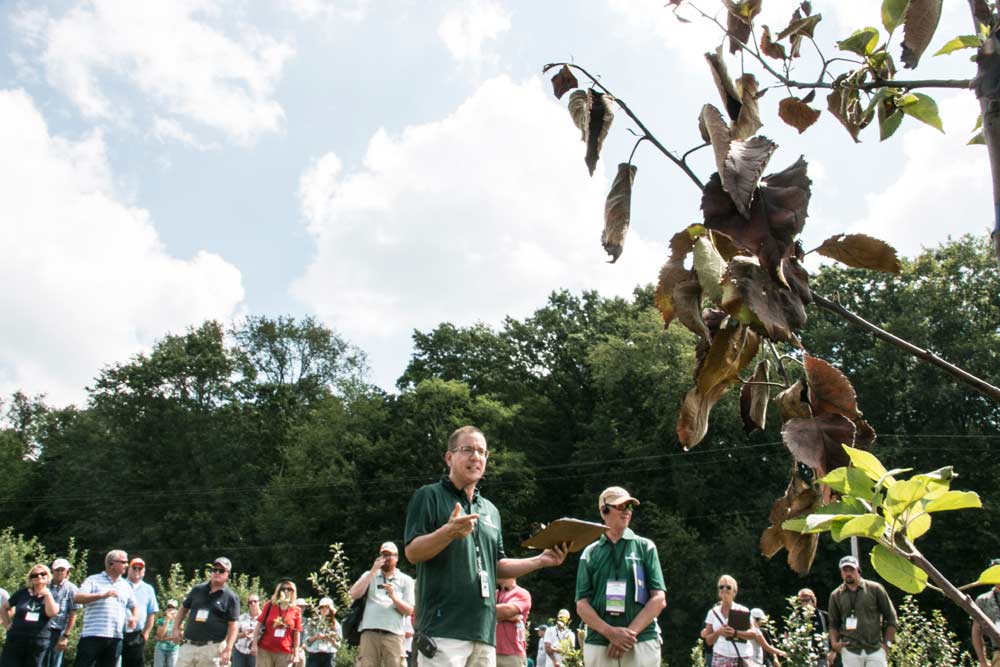
Michigan State University plant pathologist George Sundin points out an obviously infected tree in his apple scab trial Tuesday, July 18, 2017, at MSU’s main campus in East Lansing during the International Tree Fruit Association’s Summer Tour on Tuesday, July 18, 2017, near Grand Rapids, Michigan. (Ross Courtney/Good Fruit Grower)
The Michigan tree fruit industry is chock full of innovative growers rapidly diversifying, modernizing and making research-backed changes designed to deliver a more consistent, quality crop come frost, drought, hail or any other challenge.
That’s the message organizers of the 2017 International Fruit Tree Association Summer Tour want the 225 attendees to take home from the three-day event, which wrapped up Tuesday.
“They are on a fast curve of trying to modernize their orchards as fast as they can,” said Phil Schwallier, past-president of the group and a Michigan State University extension specialist.
Over the three days, tour-goers visited 10 farms, plus research facilities, to see the industry’s efforts to shift from a traditional growing area to one of multi-leader fruiting walls, motorized canopies, frost protection, irrigation tools and new equipment.
Everywhere, growers labored and tinkered to narrow their canopies and boost efficiency. Tall spindle, super spindle, V-trellis and UFO systems: “They are trying it all,” Schwallier said.
Tuesday’s third and final day focused on research, with tours to facilities run by Michigan State University, the nation’s first land-grant college and one of the cradles of modern horticulture.
An eyebrow-raising stop was a disease trial at the research farms at MSU’s main East Lansing campus. Growers reacted with a little shock at the sight of orchards dotted with dying branches, brown leaves and stunted trees infected with fire blight, scab and other pathogens.
Only plant pathologists get excited to see a dead tree, quipped George Sundin, an MSU plant pathologist. “It just means our tests worked.” The treatment may not have worked, but that’s science, he said. That’s the only way to put treatments to the test.
Sundin told growers that new cultivars of both fresh apples and cider apples are “highly susceptible” to fire blight. Currently, streptomycin, kasugamycin and oxytetracycline are the leading antibiotics, but some strains of fire blight are showing resistance.
Other stops Tuesday included tours of MSU’s Clarksville research center, one of three horticulture research facilities in the state, and of the greenhouses and laboratories at the East Lansing campus.
A major theme of the entire three-day tour was grower reaction to a May 8-9 frost that occurred during full bloom. Schwallier estimates the weather event took out between 30 and 40 percent of the region’s fruit crop. Grower used microsprinklers and wind machines to prevent things from being worse, two things new to the area in the past 10 years. Schwallier estimates the area has 500 frost fans and expects to see another 40 or 50 this year.
IFTA’s 2018 Summer Tour is tentatively scheduled for British Columbia.






Leave A Comment